The Hythe Pier Railway is but a part of the public transport link it provides between Hythe and Southampton so it would be remiss to focus only upon the pier railway while ignoring the ferry and the many other points of interest which coincidentally appear in photographs. The earliest known existence of a ferry at Hythe is 1575, being shown (as Hitheferye) on a Saxton map reproduced below.
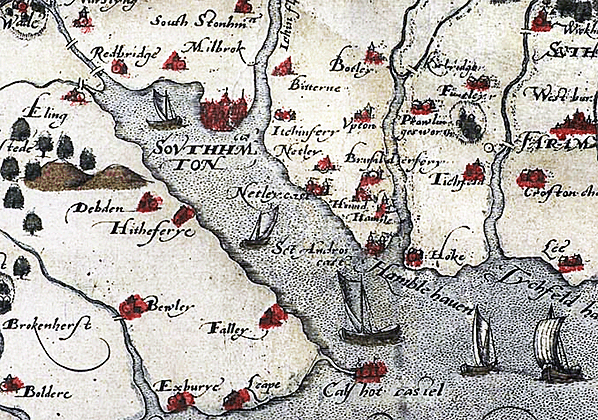
From that year and steam-powered vessels are said to have appeared as early as 1830. However and, of course, with tongue firmly in cheek, no photographs from the sixteenth century have come to light while no details are known of the early pre-pier steam vessels other than only marginally relevant records of complaints centred around the landing hard which resulted in construction of the pier. Due in no small part to the aforementioned, this article therefore centres overwhelmingly upon the period after pier-construction and relevant events at and around Southampton Docks.
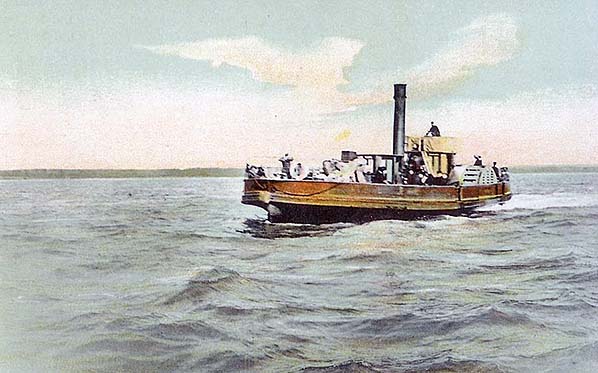
The original PS Hotspur seen here in full flight on an early postcard view. It is unclear if this scene originated as painting or a painted photograph and the land in the background looks to be too far away for the reality of Southampton Water. Hotspur was built in Plymouth in 1889 for James Percy, whose family was to own General Estates - the owners of Hythe ferry at the time. The Hotspur name was taken from a family ancestor Sir Henry Percy (1364 - 1403) who was informally known as Sir Harry Hotspur or simply Hotspur. Descendants of the Percy family owned land around Tottenham, hence the title of Tottenham Hotspur FC - a nod to the history of this part of London. The gruesome story of what happened to Sir Henry after his death is well known and his various body parts were eventually reunited and buried in York Minster. PS Hotspur was withdrawn by or during 1927. Renamed 'GEC' in order the release the Hotspur name for use on a new motor vessel, she ended up an engineless hulk in Dublin Bay and eventually rusted away.
Postcard from Simplon Postcards web site

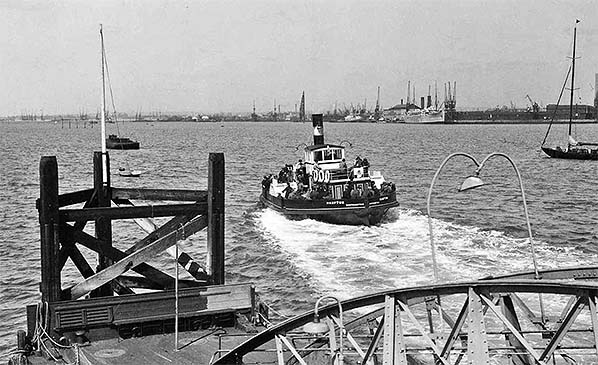
Sometime prior to 1936 PS Hampton departs Hythe pier for Southampton. Some postcard views of this vessel describe her as 'SS Hampton'; SS meaning Screw Steamer but the initials are also used generally and loosely for 'Steam Ship' regardless of propulsion method. PS Hampton dated from 1894 and was visually similar to the original Hotspur which dated from 1889. Accommodation was for 200 passengers in two deck saloons with apparently further accommodation below deck. The major difference between the two vessels was Hotspur having a single-cylinder oscillating engine while Hampton had a rather better two-cylinder compound engine. On oscillating engines the cylinder block(s) incorporated valve ports and the entire cylinder oscillated by the rotation of the crank transmitted via the connecting rod. The basic principle was the same as that used on 'Mamod' model steam engines. PS Hampton was withdrawn in the 1930s and broken up by a Dutch shipbreaker in 1936.
Photo from Simplon Postcards web site
While the two paddle steamers were in service, MV Hamble appeared during 1915. This vessel was a 40ft motor launch and aside the information give here absolutely nothing is known about her and no photographs are known to exist. Her engine would have been nothing like those we know today and could have been a Priestman, an Akroyd-Stuart (marketed under the Hornsby-Akroyd name, Hornsby later becoming the well known firm Ruston & Hornsby) or one of a handful of other makes prevalent in the field at the time. Hamble's time at Hythe appears to have been short, suggesting that she was unsuccessful, and her subsequent fate is unknown. 'Launch' in the nautical context has a number of meanings according to period but in the context of motor vessels refers to small open boats with little or no permanent superstructure and often with the forward area (at the bows) covered. Steam launches also exist and are perhaps best known today for pleasure trips on lakes and inland waterways.
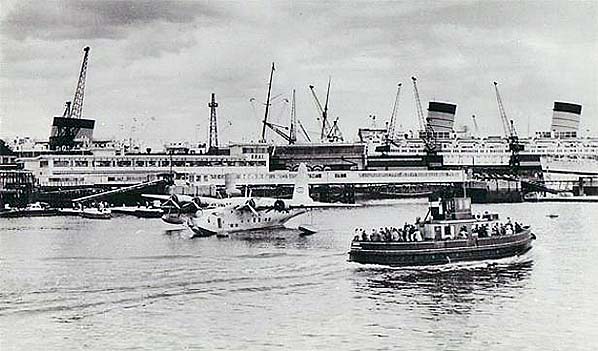
A postcard view believed to date from April 1948 showing the Hythe ferry against the familiar backdrop of Southampton docks. Present are ocean liners, with RMS Queen Elizabeth on the right, and a BOAC flying boat behind which can be seen the then new BOAC terminal building. The well loaded ferry is MV Hotspur II. One of five vessels to carry the Hotspur name, the first being a paddle steamer, Hotspur II was built at Rowhedge Ironworks, Colchester, in 1932 (some sources say 1936) and originally lacked a funnel. She was 56ft long, certified for 300 passengers and continued in service at Hythe until 1978 when she went to Scotland for service on the Clyde. Now fitted with Kelvin R6 engines, which replaced Gardner 4L3 units, and named MV Kenilworth, she is still in existence and at the time of writing was at Nairn, Inverness, but believed out of service. Kelvin Diesels is an old established Glasgow manufacturer of marine engines with a worldwide reputation but is little known outside maritime circles due to their specialist market. The flying boat is Short S.25 G-AGJN 'Hudson'. She was one of a batch of military Sunderlands converted post-World War II for passenger use with BOAC and the class was variously known as the Sandringhams or the Hythes but which is the more correct appears to be a matter of opinion. The conversion work was undertaken at Belfast by the then Short-Harland enterprise, 'Harland' being Harland & Wolff. What became G-AGJN with BOAC had twin-deck accommodation for 24 passengers with 16 sleeping berths, dining room, kitchen and cocktail bar. Engines were four Bristol Pegasus 38 nine-cylinder radial types of 1,032hp and not to be confused with the later Rolls Royce Pegasus turbofan engine. The other engine type commonly fitted to the Sunderlands was the Pratt & Whitney Twin Wasp R-1830-92 of 1,200hp. G-AGJN suffered damage, precise nature unknown, in January 1953 and is thought to have been withdrawn. BOAC (British Overseas Airways Corporation) was formed in 1939 by the merger of Imperial Airways and British Airways Ltd. The latter is not to be confused with the present British Airways which came into existence in 1974 from a merger between BOAC and BEA (British European Airways). The BOAC logo was the 'Speedbird' and this is just visible on the hull of G-AGJN ahead of the cockpit. The logo is still used today by British Airways (BA) and the Speedbird name is the BA callsign.
Postcard from Simplon Postcards web site
A few lines are worth adding about RMS (Royal Mail Steamer [or Ship] Queen Elizabeth. She was built by John Brown at Clydebank as their hull number 552 for what was then Cunard White Star and launched on 27 September 1938. Her maiden voyage took place on 3 March 1940 but owing to WWII entered service as a troopship. Becoming the intended passenger liner in October 1946, she continued in this role until 1968 with both herself and RMS Queen Mary being replaced from 1969 by the vessel commonly known as QE2. RMS Queen Elizabeth's subsequent career was a tragic one. After initially and briefly becoming a tourist attraction-cum-hotel at Port Everglades, Florida, she ended up at Hong Kong with the intention being to convert her to a floating university. During conversion she caught fire and as a result of flooding with water from fire hoses capsized and sank. The wreck broke surface and in 1974 was used as Q's headquarters in the James Bond film The Man with the Golden Gun although perhaps obviously only the exterior of the ship was filmed, interior shots being a studio set. Subsequently she was dismantled for scrap having been deemed a hazard to shipping but parts of her remain on the bottom of Hong Kong harbour to this day. Queen Elizabeth was named after the wife of King George VI who was to become Queen Elizabeth, the Queen Mother; Queen Mary was named after the wife of King George V. The former vessel had twin funnels while the latter had three, giving rise to the common misconception that Queen Mary was the larger of the two. In fact it was the other way around. A false impression of size was the reason that earlier ocean liners, such as the White Star 'Olympic' class, had four funnels with the fourth, usually that nearest the stern, having only ancillary functions.
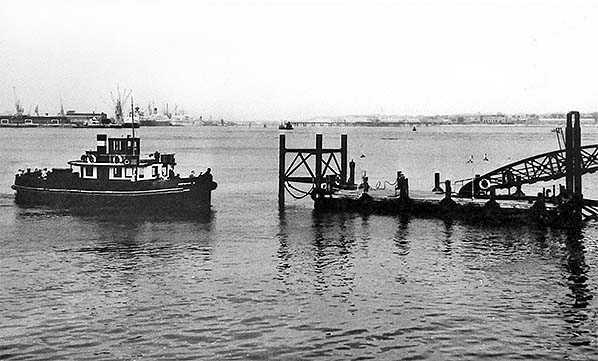
MV Hotspur II arrives at Hythe Pier. The pier-proper is out if view to the right and is linked to the landing stage by the sloping gangway. In the background and in the camera direction is the River Itchen with Woolston Jetty visible. Built at the request of the London & South Western Railway, Woolston Jetty was completed circa 1898 and was reputedly Britain's first ferro-concrete jetty, albeit to the same design as a wooden jetty. Said to have been originally much wider and shorter than its present form, it now carries a pipeline beneath its decking. There is a wharf at its head and at a right angle to it. The jetty is believed to have been altered to its present form, as seen here, in 1956 (from a somewhat vague record in the National Archives) so this would be the earliest date for this photograph.
Photo from Simplon Postcards web site
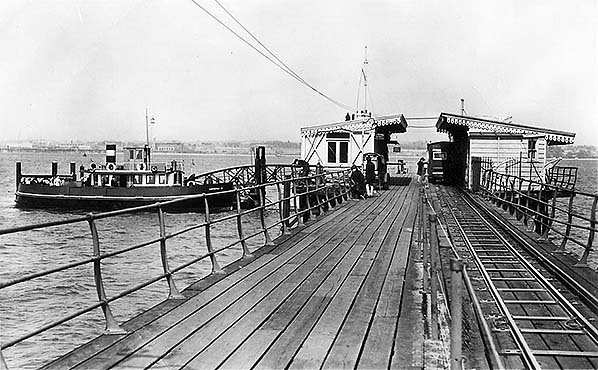
MV Hotspur II at Hythe pier on a Dearden & Wade postcard view. The date is unknown but probably 1950s and certainly prior to the pier railway locomotives receiving modified shore-end windscreens. The white or cream surround to the windscreens, as seen here, were quite prominent around this time. The semi ornate railings along either side of the pier are original and remain in situ today although there have been repairs and perhaps replacements to sections damaged due to collisions. It will be noticed from various pictures that the gangway from pier head to landing stage poises at various degrees of slope. This is standard practice to allow for tides and an absolute necessity with pontoon landing stages. Southampton Water is an example of what is geographically termed a ‘ria’, or 'drowned valley'. The name is precisely what it implies, the area once being a river valley and what is now known as Southampton Water resulted from the flooding of this valley following rising sea levels after the last Ice Age. If this is difficult to comprehend, it should be remembered that way back in history the English Channel as we know it today did not exist and the British mainland was part of the European land mass. One peculiar result of all this over many thousands of years was what is today Southampton Water having what is known as a 'double tide'. This means unusually long high tide periods; one of the reasons why Southampton Water is ideally suited to large vessels.
Photo from Simplon Postcards web site
 At one time, and in the days when the majority of people took their holidays 'at home' rather than flying abroad, it was almost mandatory to send postcards to friends and family and often with the 'Wish you were here' cliché. To a much lesser degree postcards are still sent but the postcards of today tend to depict beach scenes, mountain scenes, gardens and so on with all scenes being photographed on apparently gloriously sunny days. Not everywhere can boast such scenes and in these cases best use was - and is - made for photographic purposes of what facilities were or are available. It should be remembered that in the heyday of the British holiday few people could afford to, or wished to, holiday abroad and at a time when annual holidays amounted to just one, or at best two, weeks per year and often unpaid at that, this was the only chance people living at inland locations got to see the sea, travel on a boat or ship or indeed travel any distance at all. Therefore a walk along a pier could be a holiday highlight and where there was a pier railway an additional novelty was on offer. For anybody taking a holiday, or perhaps just a weekend, at Hythe the trip along the pier and the ferry crossing to Southampton which, if lucky, would enable people to see the big ships could be what made a holiday. If we can understand this, we can then understand why postcards such as those depicting the Hythe pier railway and the ferry were produced.
At one time, and in the days when the majority of people took their holidays 'at home' rather than flying abroad, it was almost mandatory to send postcards to friends and family and often with the 'Wish you were here' cliché. To a much lesser degree postcards are still sent but the postcards of today tend to depict beach scenes, mountain scenes, gardens and so on with all scenes being photographed on apparently gloriously sunny days. Not everywhere can boast such scenes and in these cases best use was - and is - made for photographic purposes of what facilities were or are available. It should be remembered that in the heyday of the British holiday few people could afford to, or wished to, holiday abroad and at a time when annual holidays amounted to just one, or at best two, weeks per year and often unpaid at that, this was the only chance people living at inland locations got to see the sea, travel on a boat or ship or indeed travel any distance at all. Therefore a walk along a pier could be a holiday highlight and where there was a pier railway an additional novelty was on offer. For anybody taking a holiday, or perhaps just a weekend, at Hythe the trip along the pier and the ferry crossing to Southampton which, if lucky, would enable people to see the big ships could be what made a holiday. If we can understand this, we can then understand why postcards such as those depicting the Hythe pier railway and the ferry were produced.
As time has marched on these postcards depicting what some may considered rather dull and almost industrial scenes have proved invaluable for historical purposes and especially when postcards have been postmarked, and thus dated. Thousands of postcards were produced showing railway stations, often with a train and staff present, and these are also now invaluable for historical purposes. Without these postcards there would surely be huge voids in our history and indeed, most surviving photographs of the Hythe ferry in bygone days are in postcard form.
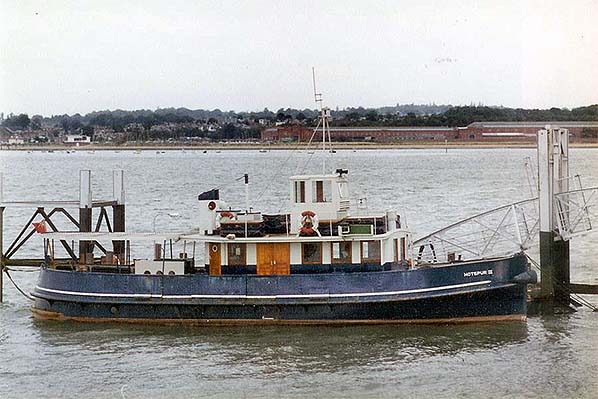
A nice view of the starboard side of MV Hotspur III at Hythe Pier landing stage. Another product of Rowhedge Iron Works, she was new in 1938 and generally similar in appearance to Hotspur II. Apart from the name, the main visual difference in later years was the style of her funnel which displayed a move away from the style of steam-era funnels which persisted for many years on smaller motor vessels. Precisely what her original engines were is unclear but it is known she was given Gardner 4L3 units in 1949 and these were in turn replaced by Kelvin R6 units in 1971. She was scrapped in 1981 due to a corroded keel but her Kelvin engines were installed in MV New Forester which appeared in 1982.
Photo from Simplon Postcards web site
It is worth adding an explanation of a few common nautical terms. When looking forward, towards the bow (looking towards the stern, the rear, is 'aft'), the left side of a vessel is the Port side and the right side is Starboard. Navigation lights are red and green respectively. Mast lights are white and by use of these colours it can be determined the direction a vessel is sailing at night. The Keel is the backbone of a vessel and is situated at the bottom of the hull. When a vessel is built, the keel is the first item to be laid down and from it the hull is constructed. The exhaust stack of any vessel, irrespective of power source, is always a Funnel, not a chimney although the term 'exhaust stack', which is American in origin, does seem to be creeping in with reference to modern ocean liners. Superstructure is the permanent structure mounted upon the deck and contains the bridge or wheelhouse and other accommodation according the vessel type. Marine engines differ to those used in road and rail vehicles in a number of ways but the major difference is the lack of a radiator-based cooling system; coolant simply being drawn in from sea, river or lake, circulated around the engines and pumped out to whence it came. Gardner engines are perhaps better known for being fitted to buses and to British Railways' smaller diesel shunting locomotives, in which latter application the 6L3 and 8L3 versions were used. The 4L3 is in effect a half-sized version of the 8L3 and adapted for marine use, a variant of the 4L3 being the 4LK as used in the WWII X-class midget submarines and in the 4LK's road vehicle form as the power unit for the horrible little Bristol SC4LK bus.
As applied to Hythe ferry vessels, the Gardner 4L3 was rated at 65ihp. The initials relate to ‘Indicated Horse Power’ which, in a nutshell, is the power developed by the cylinders without taking into account frictional and other losses. Together with shp (Shaft Horse Power, i.e. power at the propeller shaft) ihp is commonly used in marine specifications.

MV Hotspur IV seen here in Waterfront Ferry livery, the same livery worn by the pier train at this time. This vessel wore a number of liveries and is perhaps best known for her former and rather drab green livery and the red and white White Horse Ferries livery which she still wears at the time of writing. New in 1946, her story is similar to those of Hotspur II and Hotspur III but she is longer (64ft against 56ft) and was originally certified to carry 350 passengers. Length aside, a major visual difference with Hotspur IV is her funnel being located further aft. Unfortunately in 2014 the Maritime and Coastguard Agency deemed Hotspur IV unfit for further service owing to hull corrosion and, at the time of writing, her future is uncertain.
Photo from Simplon Postcards web site

The pier train makes its way shorewards on 11 March 2007. At the landing stage, left background, is MV Hotspur IV. It has always been the case that Hythe ferry can carry a great many more passengers than the train and in the case of more recent vessels approximately seven times as many. One may therefore wonder what happens at busy periods; the answer is simply that many people walk along the pier as evidenced in this view. Nevertheless, and as is well known, the pier train was and still is very well used. Tickets for the ferry crossing obviously include admission to the pier and also a complimentary - as the operators call it - train ride. Tickets are also available for pier and train only, these being popular with visitors including enthusiasts who wish only to partake of the train.
Photo by Simon Palmer and reproduced from Geograph via Creative Commons Licence
The ferry service and pier had been owned for many years by General Estates, described briefly on the Hythe Pier Railway page, but from 1980 a number of changes of ownership took place. These were to Southern Coastcraft, then Waterfront Ferry (see picture of Hotspur IV) then White Horse Ferries and their subsidiary Hythe Ferry Ltd. This explains the livery changes in recent decades but also complicates the story due to the arrival and departure of several further vessels in a relatively short space of time. Meanwhile, in 1978 the Hotspur name was to appear yet again in the form of MV Hythe Hotspur, a renaming of a vessel which had been new in 1974 to the Portsmouth Harbour Ferry Company (PHFC) and named Southsea Queen. The PHFC had a sizeable fleet over the years, many of which vessels bore names with nods to royalty. Southsea Queen was a much more businesslike vessel and had been designed for tours and excursions around Portsmouth Harbour. She continued this roll around Hythe and Southampton and could also act in the capacity of stand-by ferry. Remaining at Hythe until 1995, she was sold to a new owner at Poole and is subsequently believed to have operated river trips in Wiltshire.
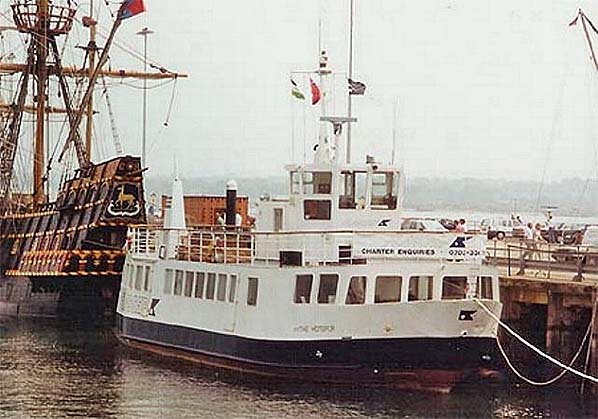
MV Hythe Hotspur seen here at Southampton. The vessel behind her is the Golden Hinde, the 1973-launched replica of Sir Francis Drake's ship Golden Hind which dated from 1577 and was originally named Pelican. Note the two spellings, ‘Hind’ and’ Hinde’. There have been other Golden Hind replicas but Golden Hinde is the only one to be full size and the only one capable of ocean sailing. She has toured the world and taken part in a number of events and indeed she has sailed the equivalent of five times around the world. As of 2016 she is at St Mary Overie Dock, Southwark and used mainly for educational purposes. By coincidence there was only two years between the original Golden Hind and the first confirmed existence of a ferry at Hythe.
Photo from Simplon Postcards web site
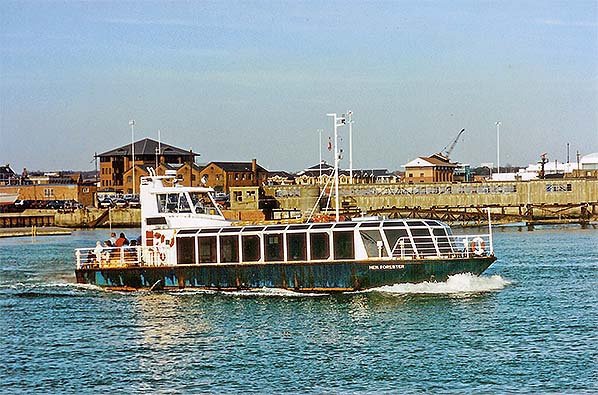
MV New Forester departing Southampton on her way to Hythe. She is a 'waterbus' style vessel and arrived at Hythe, believed new, in August 1982. She is fitted with the Kelvin engines from Hotspur III which had replaced the latter vessel's Gardner engines in 1971. Vessels certified as capable of going to sea, which in very simple terms means any motor vessel not confined to inland waterways, are required by law to carry or be fitted with certain items of equipment - one of which is at least two engines. In this view traces of the previous red livery applied to her hull are showing through. Her configuration may not have been fully suited to the short Hythe - Southampton crossing and she was sold in 1999 having being taken out of front-line service in 1995. She initially went to Totnes for pleasure trips on the River Dart and then, renamed Golden Star, to London where she now performs a similar function
on the River Thames.
Photo from Simplon Postcards web site
The replacement for MV New Forester transpired to be MV Great Expectations. She is a catamaran built by White Horse Ferries (WHF) at Gravesend in 1992 (completed 30 June 1992 as Yard No.0001) for the WHF Tilbury - Gravesend service and she was sent to Hythe in 1995 to take over from MV New Forester as Hythe ferry's front-line vessel. Her name is properly MV Great Expectations C.D.; after the Charles Dickens novel in which the lower regions of the River Thames are a dominant feature. Given a £50,000 refit in 2008, the vessel continues to operate the Hythe ferry at the time of writing with, according to Hythe Ferry Ltd., MV Hotspur IV in reserve notwithstanding concerns with this vessel's hull. MV Great Expectations is 21 metres long with a beam of 4 metres. 'Beam' is the width of a vessel at its widest point. Her callsign is MQBW5 and her MMSI number is 235083239.
Maritime callsigns are, put simply, a means of vessel identification for use over the radio and hark back to the days of radio communication via Morse Code and were themselves derived from station codes used in the telegraphs of American railroads. Some famous maritime callsigns were RMS Titanic - MGY (originally MUC); RMS Olympic - MKC; RMS Queen Elizabeth - GBSS; RMS Queen Mary - GBTT, while the modern RMS Queen Mary 2 is ZCEF6. Callsigns are allocated only to commercial vessels, non commercial vessels use the vessel name. MMSI (Marine Mobile Service Identity) numbers are 9-digit codes transmitted digitally to identify the individual vessel, global region, equipment and so on. MMSI codes contain Marine Identification Digits which in the case of MV Great Expectations are 235, the '2' signifying a European vessel. Otherwise the MMSI system is extremely complex and a detailed description would be both irrelevant and impractical here

Still in her red and white livery, MV Great Expectations approaches Hythe Pier on 22 April 2010. Stealing the show is RMS Queen Mary 2, here departing Southampton for New York. Whilst nobody can deny the modern Queens are impressive, they lack the style and character of the older liners. Like her predecessor Queen Elizabeth 2, Queen Mary 2 operates a seasonal transatlantic service and cruises at other times of the year. Unlike Queen Elizabeth 2, Queen Mary 2 has the RMS designation and at the time of writing is one of only four remaining British, or British origin, vessels to do so. Of those, one, RMS Segwun, is steam powered. She operates in Canada and is that country's sole remaining steamship still in operation. Built at Saint-Nazaire, France, Queen Mary 2 was launched on 21 March 2003, completed on 23 December that year and sailed on her maiden voyage on 12 January 2004. Her displacement is 79,297 tonnes, length 345 metres, height 72 metres from keel to top of funnel, beam 41 metres at the waterline and 45 metres across bridge wings. She has a total of 18 decks, 14 of which are for passengers and following her 2016 refit will carry a total of 2,695 passengers (as built the total was 2,620) and 1,253 officers and crew.
Photo by Peter Trimming and reproduced from Geograph under Creative Commons Licence
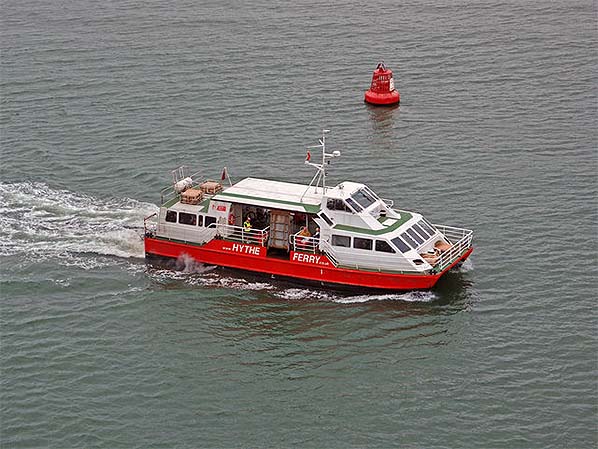
On 13 August 2011 MV Great Expectations makes her way upstream from Hythe to Southampton. If the grid reference for this photograph is correct, she is passing Gymp buoy. The buoy's name is on the plate visible here but is unreadable. Gymp buoy marks the position of a sandbank upon which RMS Titanic supposedly grounded when departing on her maiden voyage. Titanic's departure from Southampton was not without incident and as a result details of the supposed grounding have become somewhat pushed into the background but it would seem Titanic at worst scraped her keel on the sandbank as she passed. Few published sources make mention of the alleged incident; the majority make no mention. Titanic was a little over an hour late by the time she passed Hythe due to the mishap involving the SS New York (See text, below) but no delay has been attributed to any incident involving a sandbank. The white barrel-shaped object at the stern of Great Expectations is a pod containing an inflatable liferaft. Note how the Hythe Ferry branding is neatly stood out from the
operator's website address.
Photo by WF Millar and reproduced from Geograph under Creative Commons Licence
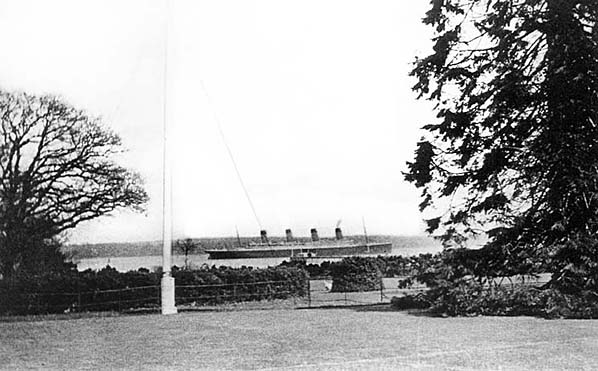 This extremely rare view shows a White Star liner passing Hythe and is out of chronological order as it links to the previous image caption. The photograph is believed taken from near what is today the junction of Prospect Place and Jones Lane, Hythe, with the area off to the left being what is now Hythe Marina Village and constructed in 1985 on an area of what was mudflats. In the centre of the picture can be seen Hythe Pier, its railway - then technically a tramway - at this time still being manually operated. The railway through Hythe to Fawley was yet to be built, for the date is 10 April 1912 and the photograph is also a very sad one for the liner is RMS Titanic departing Southampton on her maiden voyage to New York, a destination she was never to reach for in the early hours of 15 April she plunged 2½ miles to the bottom of the Atlantic taking 1,513 passengers and crew with her. The photograph was taken shortly after Titanic's altercation with the SS New York which caused a delay of just over one hour so the photograph would have been taken around 1.30pm and likely no later.
This extremely rare view shows a White Star liner passing Hythe and is out of chronological order as it links to the previous image caption. The photograph is believed taken from near what is today the junction of Prospect Place and Jones Lane, Hythe, with the area off to the left being what is now Hythe Marina Village and constructed in 1985 on an area of what was mudflats. In the centre of the picture can be seen Hythe Pier, its railway - then technically a tramway - at this time still being manually operated. The railway through Hythe to Fawley was yet to be built, for the date is 10 April 1912 and the photograph is also a very sad one for the liner is RMS Titanic departing Southampton on her maiden voyage to New York, a destination she was never to reach for in the early hours of 15 April she plunged 2½ miles to the bottom of the Atlantic taking 1,513 passengers and crew with her. The photograph was taken shortly after Titanic's altercation with the SS New York which caused a delay of just over one hour so the photograph would have been taken around 1.30pm and likely no later.
Courtesy of MaritimeQuest
The Titanic disaster needs no discussion here as it has been well covered in numerous books and documentaries, especially since the wreck was discovered in 1985 and consequently information has become rather more factual. However, and notwithstanding Titanic being seen at Southampton only once, the Olympic class ships were a familiar sight passing Hythe so a little general information is warranted. The three vessels were RMS Olympic (Harland & Wolff Yard No.400, launched 28 October 1910), RMS Titanic (H&W Yard No.401, launched 31 May 1911), HMHS Britannic (H&W Yard No.433, launched 26 February 1914). The three vessels were not identical and it is myth that the three were difficult to tell apart. Britannic was requisitioned for use as a hospital ship, hence HMHS, when still at Belfast and among other changes she was painted in the usual livery for a hospital ship of white with red crosses. She was also built, in the wake of the Titanic disaster, with additional lifeboats and both features made her instantly recognisable. Titanic as designed was externally similar to Olympic apart from minor details, such as ventilator design, which were difficult to discern from the shore. Olympic's first class promenade deck (A Deck), located below the boat deck, was exposed to the weather and thus found unsatisfactory. At the last minute the same deck on Titanic was modified to be partially unclosed at its forward end on both port and starboard sides. Olympic was never so-modified and to this day the difference makes the two vessels easily identifiable in photographs. In the photograph of Titanic passing Hythe Pier, the modification to the deck is just discernible below the first two funnels and in comparison with the remainder of the deck midships and aft. HMHS Britannic made a number of voyages from Southampton having entered service on 23 December 1915, until she struck a mine in the Kea Channel (Greece) and sank. Of the 1,065 persons on-board, all bar 30 were saved. Her wreck lies at 120 metres on its starboard side and at the time of writing is generally intact and in remarkably good condition. Olympic had been involved in a number of incidents, including collisions, but otherwise had a successful career including as a troopship during WWI. Following the Titanic disaster she received a number of modifications including additional lifeboats. Her final voyage was from New York on 5 April 1935. She was ultimately towed to T W Ward's yard at Inverkeithing in 1937 and scrapped. Many of her fixtures and fittings have survived, however, and today are scattered around various locations, most famously at The White Swan Hotel, Alnwick, while the clock from her Grand Staircase can be seen at the SeaCity Museum, Southampton. We therefore today have the bizarre situation, insofar as the Olympic class vessels are concerned, whereby the two vessels which had tragic careers still exist albeit as wrecks, yet the vessel which enjoyed a successful career no longer exists.
RMS Titanic was due to depart Berth 44 at noon on 10 April 1912 and this she duly did, being manoeuvred by tug to the Lower Swinging Ground of the River Test after which she would proceed under her own steam. A little further on she passed Berth 38 where White Star RMS Oceanic and American Line SS New York (originally Inman Line SS City of New York) were laid-up side by side due to a coal miners' strike which had been ongoing at the time. Turbulence caused by Titanic caused SS New York to break away and drift stern-first towards Titanic. Titanic's port propeller (she had three) was boosted to create a force of water hopefully to push SS New York clear. The tug Vulcan, which was one of the tugs which had been engaged in manoeuvring Titanic from her berth shortly before, attempted to restrain SS New York but accounts then vary as to what happened next. Some say Captain Smith gave the 'Full Astern' order to Titanic's engineroom, others say he gave the 'All Stop' order while others say both orders were issued in succession. The latter is the most likely scenario but stopping or reversing engines of a large steamship was no simple matter and executing either order took several minutes. Most sources say Captain Smith issued the orders during the SS New York incident but in reality Titanic would have been under the command of the harbour pilot. Whatever actually took place on Titanic's bridge, she did eventually come to a stop. SS New York was eventually to drift past Titanic's bow to end up adjacent to what is now Berth 36 of the Eastern Docks, at the mouth of the River Itchen. It is said that SS New York came within four feet of Titanic but no collision occurred, owing in no small part to the crew of Vulcan. After a delay of a little over an hour, Titanic steamed on her way past Hythe to Cherbourg, Queenstown (Cobh) and oblivion. She was photographed leaving Queenstown heading out into the Atlantic and was not to be photographed again for 73 years.

MV Great Expectations seen here on her way to Hythe on 28 August 2007. Dominating the scene is Red Funnel vehicle and passenger ferry MV Red Osprey. She is passing Hythe Knock buoy while operating the Southampton - East Cowes (Isle of Wight) service. Built on the Clyde by Ferguson Marine Engineering, she was new to Red Funnel as a member of the Raptor class and launched in 1994. Her capacity is 895 passengers and 220 cars. During 2009 she wore a blue and yellow livery to promote the then new IKEA store in Southampton, after which she returned to her standard Red Funnel livery as seen here. She was given a refit in 2015 along the same lines at that given to her sister, MV Red Falcon, and had previously been refitted and extended (to her present capacity) at Gdansk, Poland, during 2003. Whilst the Poles are lovely people and absolutely no disrespect is intended, there is something very wrong when Britain's shipyards are but a mere shadow of what they once were while work is contracted to Eastern Europe and elsewhere. But this, sadly, is 21st century Britain.
Photo by Jim Champion and reproduced from Geograph under Creative Commons Licence
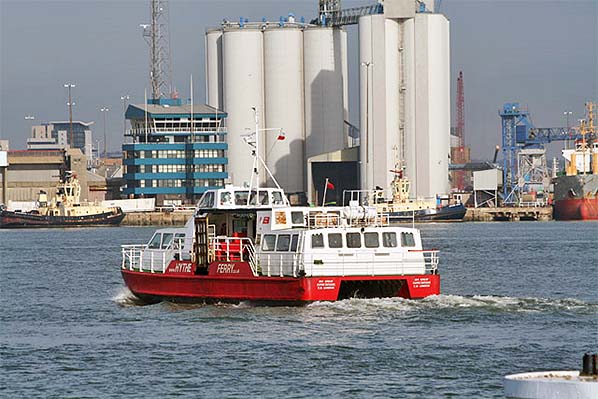
On 12 February 2009 MV Great Expectations is seen on her way to Southampton shortly after departing Hythe Pier. This view looking towards her stern gives an idea of catamaran design. In effect there are two hulls as opposed to conventional monohull vessels. The design offers a number of advantages: shallower draft (the depth of the hull below the waterline); smaller bow waves; less wake; lighter weight. In theory these are plus points insofar as Southampton Water is concerned although the use of a catamaran on a short, low speed service such as the Hythe ferry could arguably be called something of an overkill. The issue of catamaran v. monohull is described by some as a 'trade-off'. Catamarans have a niche, perhaps, on longer distance and higher speed ferry services such as the Isle of Man Steam Packet's 'Seacat' where at speed they skim the water in a manner which could be likened to water skis. The catamaran (often abbreviated to 'cat') design is not, however, suited to large vessels such as ocean liners and freighters. On both sides of Great Expectations stern can be seen her name in full (i.e. with the 'C.D') and her port of registry - London. The grain terminal is on the spit between the Rivers Test and Itchen. Two of the Port of Southampton's tugs, in their distinctive livery, can be seen at the quay. The cargo vessel partly in view in the right background is tied-up at the approximate spot where SS New York was to finish up following her skuffle with RMS Titanic back in 1912.
Photo by Peter Langsdale and reproduced from Geograph under Creative Commons Licence
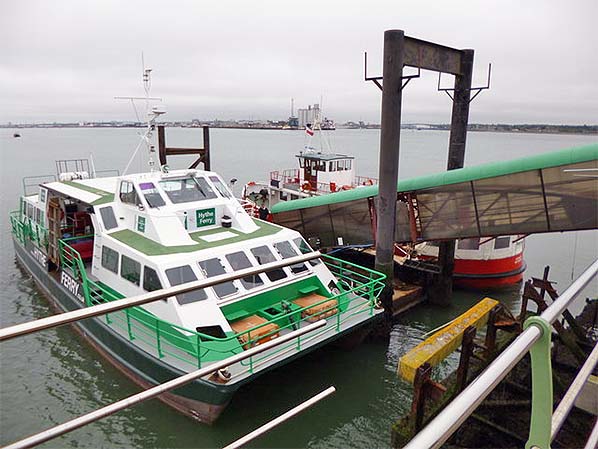
MV Great Expectations at Hythe landing stage and viewed from the pier on 27 June 2012. She is displaying her then-latest livery of black, white and green. Attractiveness, or otherwise, of this livery is a matter of opinion but at least it distinguishes her from the Red Funnel vessels. Tied-up on the other side of the landing stage is MV Hotspur IV. Conveniently visible in the background is Southampton Grain Terminal; this gives an idea of the course taken by Hythe ferry when compared to the previous image. By this date the gangway between pier and landing stage has acquired the luxury of enclosure. In the left background can be seen Hythe Knock buoy and upstream of Hythe pier there is a maximum speed limit of 6 knots. A 'knot' is a measure of speed based upon the nautical mile and equates to 1.15mph. A 'nautical mile' is one minute of latitude, there being 60 minutes to 1 degree of latitude. The term 'knot' originated in the days of old when the speed of a vessel was calculated by paying out a rope, knotted at regular intervals, from the vessel's stern. The number of knots paid out were counted over a given period of time and thereby the speed of the vessel was calculated. Knots are also used in meteorology and by aircraft.
Photo by Mike Faherty and reproduced from Geograph under Creative Commons Licence
From time to time the Hythe ferry service is suspended due to weather conditions, usually high winds, while at other times a replacement vessel has to be brought in if the regular performer is out of action for any reason. One such instance of the latter saw MV Uriah Heep brought in from the Tilbury - Gravesend service, also operated by White Horse Ferries Ltd. On the evening of 13 May 2016, which happened to be a Friday, she collided with Hythe Pier and according to a report in the Southern Daily Echo the following day high winds were a factor and three of her twenty passengers received minor injuries. The Maritime Herald also reported a blackout* as well as the vessel taking on water, presumably following the collision. [*'Blackout' in the maritime context means the loss of propulsion and failure of auxiliary equipment dependent upon operation of the main power plant(s).]
The vessel's wheelhouse was extensively damaged and according to the same sources she was removed to Hamble for repairs. MV Great Expectations was out of service for a refit so a vessel was chartered from
Blue Funnel to maintain the service. .
MV Uriah Heep is one of a series of six trimaran vessels built by White Horse at their Gravesend yard, the others being MVs Martin Chuzzlewhit, Wilkins Micawber, Philip Pirrip, Daniel Quilp, Abel Magwitch. As these rather wonderful names suggest, they are characters from various Dickens novels; MV Uriah Heep being named not after a rock band but from a character in David Copperfield. The fleet was intended mainly for commuter services on the Thames but anyone attempting such an enterprise is brave indeed as Thames commuter services have generally never been a huge success. Perhaps because of this MVs Uriah Heep and Philip Pirrip were laid-up from new at Gravesend for some years.
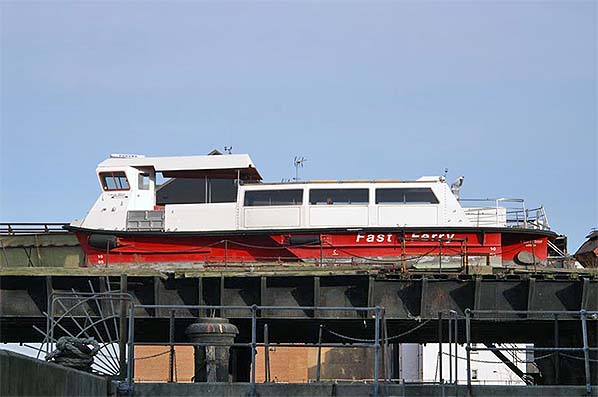
MV Uriah Heep, built in 1999, seen here on 12 March 2006 laid-up on the railway pier at Gravesend - the location of the White Horse yard. As mentioned in the text, she is a trimaran vessel, meaning that she has a main hull of broadly conventional, but differing in detail, design plus two small outrigger hulls - one to port and one to starboard. The trimaran design is more familiar on sailing yachts. MV Uriah Heep and her sisters have a rather odd appearance which is not particularly evident in this view looking towards her port side. The May 2016 collision with Hythe pier saw her bow wedged beneath the pier and her wheelhouse and the canopy behind it wrecked. The passenger area appears to have escaped undamaged, perhaps other than some superficial damage. She is 18 metres long, with a beam of 6 metres and a maximum draft of 2.5 metres.
Photo from Simplon Postcards web site
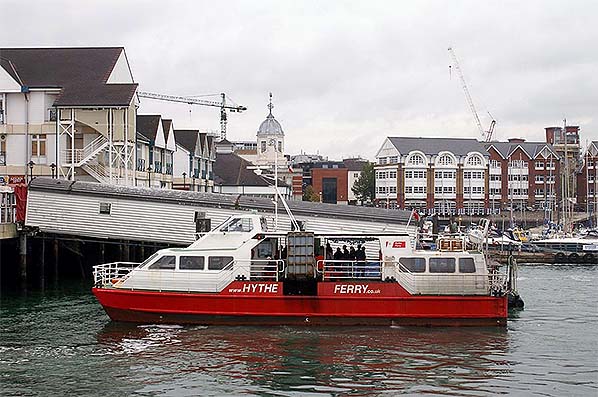
MV Great Expectations at Town Quay, Southampton, on 28 October 2006. This view shows well the modern developments which have taken place around this area of the docks. The building in the background with the domed tower is the 1910-built former Harbour House. It is now the Playhouse Gentlemen's Club, the name offering a clue as to its current use.
Photo from Simplon Postcards web site

Photographed from the Hythe ferry on 26 June 2014, this is the sight which greets passengers as they arrive at Town Quay, Southampton. It is perhaps not quite as dismal as the equivalent facility at Hythe. The wooden structure on the left is the end of the walkway from the quay-proper, at which the ticket office and other facilities are located. Beyond the marina but largely out of view is the car park for the Ocean and Queen Elizabeth cruise terminals. Town Quay is shared by the Hythe ferry and Red Funnel's vehicle and Red Jet services to the Isle of Wight but otherwise the location is now non commercial in the shipping context.
Photo by Rudi Winter and reproduced from Geograph via Creative Commons Licence.
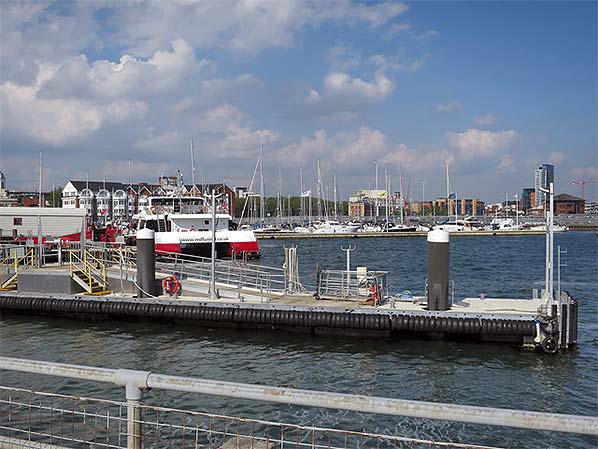
TTown Quay, Southampton, seen here on 26 May 2016. The Hythe ferry facility is to the left. Present is a Red Funnel 'Red Jet' passenger ferry for the Isle of Wight. Like MV Great Expectations, Red Jet vessels are catamarans. A new vessel, Red Jet 6, entered service in July 2016. Built at Cowes, she is powered by four MTU 2000 diesel engines each driving a water-jet propulsion unit and is capable of 38 knots. The vessel seen in this view is one of the earlier, but no less impressive, members of the Red Jet fleet. It is possible to purchase a through ticket from Cowes to Hythe involving, of course, a change of ferries at Town Quay.
Photo by Rudi Winter and reproduced from Geograph via Creative Commons Licence.

The jetty at Town Quay, Southampton, on 2 October 2016. As is clear, this jetty is no longer used by maritime traffic and has become a car park with ferries using the quayside proper. Red Funnel operates from the left background and Hythe ferry off to the right. Note the disused length of railway track; a remnant of the once extensive system serving the docks. What is left of the system handles mainly container traffic and some cruise liner traffic. The so-called 'Electric Spine' rail route to Southampton as used as propaganda by the now thankfully defunct Gideon Osborne would appear, at the time of writing, to be dead in the proverbial water.
Photo by Robin Webster and reproduced from Geograph via Creative Commons Licence.
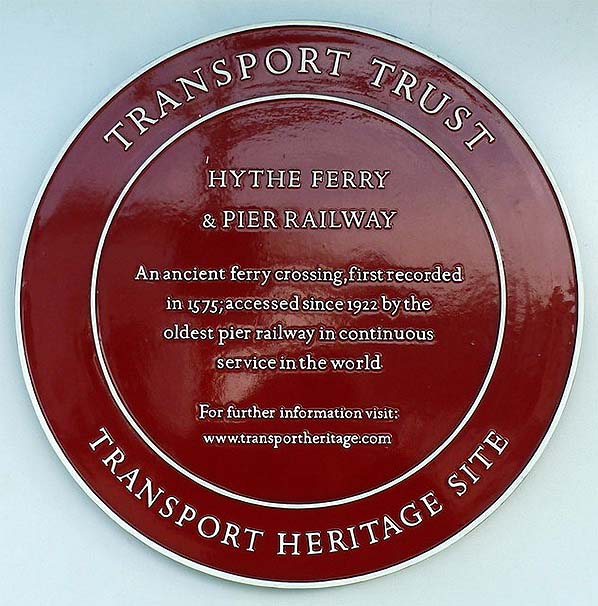 To end our trip through the years back at Hythe, this self-explanatory plaque can be seen at the shore end of Hythe pier. The photograph was taken on 12 March 2013 and the plaque dates from July 2010.
To end our trip through the years back at Hythe, this self-explanatory plaque can be seen at the shore end of Hythe pier. The photograph was taken on 12 March 2013 and the plaque dates from July 2010.
Photo by John Lucas and reproduced from Geograph via Creative Commons Licence.
Ticket from Michael Stewart
Sources (Online):
Sources (Books):
- Titanic - An Illustrated History, Don Lynch/Ken Marschall/Robert D. Ballard, Hodder & Stoughton 1992. ISBN 0-340-56271-4.
- Ocean Liners, Robert Wall, Quarto Limited 1977. ISBN 0-906286-20-4.
Further Reading:
Of the online sources given above, the Associated British Ports and related sites are worth studying even for people with no particular salt in their blood. Especially recommended are the MaritimeQuest and Simplon Postcards sites. The latter has been heavily drawn upon in preparing this feature, with the knowledge and consent of its owner, and the site by no means focusses only upon the Hythe ferry.
Newspaper articles, especially archived historical articles, are a good - and sometimes the only -source of information but should not be relied upon for accuracy. This observation is not a sneer at the press for it must be remembered that competition dictates that reporters rush to get stories into the next edition and often this is before the full facts of an incident or event become known. Also, reporters are not - nor can they be expected to be - experts on every subject. For this reason when there is a specialist publication available such are frequently the most accurate.
Persons interested in learning more about White Star Line's Olympic Class vessels, in particular about RMS Titanic, are advised to seek factual books published subsequent to the discovery of the wreck. Such books understandably focus upon Titanic but invariably also cover her two sister ships to varying degrees as well as vessels involved in the rescue and recovery of the deceased from the ocean including the Cunard vessel RMS Carpathia and her master, Captain Arthur Rostron. Captain Rostron died in 1940 and is buried at West End Church, Southampton, with the nearby Rostron Close named after him.
See Hythe Pier Railway


 Home Page
Home Page 

 Home Page
Home Page